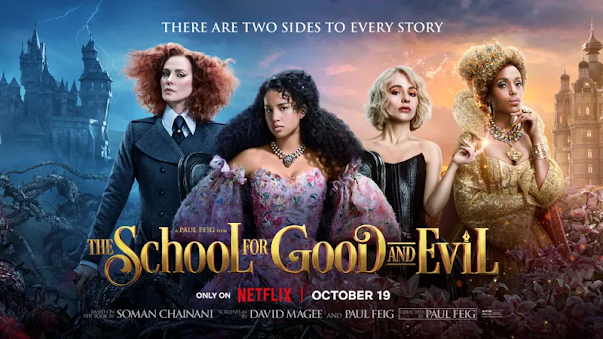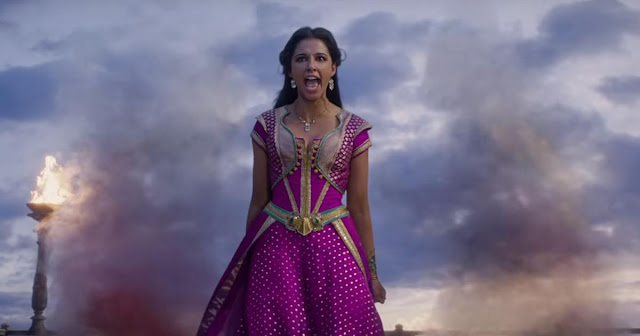Review: The School for Good and Evil (Netflix)
Back in June when I found out that Netflix was making a movie adaptation of The School for Good and Evil, I went ahead and read the first book in the series. I liked the idea of a school for fairy tale characters, but it left me with a lot of questions regarding how changing their childhoods would alter their stories and why the author had such a superficial perception of good, evil, and girls in general. The Netflix adaptation resolved many of these issues by cutting irrelevant scenes and dialogue and making just enough minor changes to the plot to make it more coherent. Was it a perfect movie? It was never going to be, considering the source material. The filmmakers did a great job of salvaging whatever substance they could find from the book and turning it into a fun teenage romp with gorgeous costumes.
The School for Good and Evil is about two girls named Sophie and Agatha who live in a backwoods town called Gavaldon. Though the other people in the town are cruel to Agatha and mockingly call her a witch, she is happy as long as she has Sophie by her side. Sophie, on the other hand, wants more out of life. She dreams of becoming a princess and living a life of fairy tales and adventure. Where the book focuses mainly on Sophie and Agatha's differences and how unlikely they are to become friends, the movie does a fantastic job of portraying their deep bond with some stellar acting and dialogue that reminds us what it was like when our best friend was the most important person in our lives and nothing else mattered. Sophie and Agatha are there for each other through thick and thin, telling off bullies, sharing inside jokes, and bonding over their favorite things. I thought their friendship was much stronger in the Netflix film than it ever felt in the book.
Once we get to know our heroines, they are whisked away to the School for Good and Evil, where Sophie is forced to mingle with a bunch of goths and furries, while Agatha gets trapped in a nightmare of her own with a bunch of stuck-up princesses who are just as cruel to her as the children from her village. This is where the movie tries to redeem the inconsistencies of the book. In the book, Agatha was a confusing person who was obsessed with death, played cruel pranks, and tried to sabotage Sophie to get her to leave the school. Meanwhile, Sophie was obsessed with princesses and goodness but constantly went off the rails with little explanation until she ultimately killed someone with no repercussions. The movie made both of these characters more consistent and relatable. No longer carrying around dead animals, Agatha is a reluctant hero with all the potential in the world except self-confidence. Sophie's actions are also more consistent thanks to the film introducing the character of Rafal much earlier than the book. Instead of having Sophie act out for no reason, all of her wicked acts were prompted by Rafal's manipulation to revolutionize the school.
While I enjoyed the changes that were made and understood the reasoning behind them, I think that hardcore fans of the book series might be disappointed because so much was cut. The majority of the scenes that were cut for the Netflix adaptation involved magical transformations that enhanced the setting of a magic school but added little to the story. I could see that the majority of the film's budget went into the costumes, leaving little room for visual effects. The one aspect of the book that the film was lacking, as a result, was Agatha's proficiency in class. In the book, she quickly became an expert at magic and excelled in all her own classes at the School for Good while helping Sophie with her classwork in the School for Evil by disguising herself as a cockroach and whispering all the answers in her ear. Here, the only thing Agatha got graded on was smiling, which she immediately failed. One benefit of the lack of magical transformations is that the film excluded all of the gratuitous underage nudity that the author featured to a disturbing degree in the book.
The School for Good and Evil is a fun and harmless fantasy flick for young audiences. It removed all of the disturbing imagery and questionable moral decisions on behalf of the main characters that made me uncomfortable when I read the book. The Netflix adaptation is a simple and somewhat forgettable story that reminded me of many similar teen movies like Disney's Descendants. I loved the costumes, especially all of the gorgeous princess gowns featured throughout, though I was surprised that the movie acquired the rights to Tchaikovsky's "Sleeping Beauty Waltz" for a key makeovers scene after Disney refused to give the rights to the melody to a Barbie movie that never got made. If you're looking for a quick fantasy fix, this movie is a perfectly fine option, which, unlike the book, is safe to share with your kids.












Comments
Honestly it's something I always wanted, as a child I grew up more with the Fairy Oak trilogy based on two twin witches (in a different style than brooms and wands) than with Harry Potter, I wanted female protagonists! I have always wanted someone to write a long series where readers can grow with their protagonists but that is focused on princesses, fairies, etc... something as if a protagonist like Sophia the first went to an academy and we could see her grow in each book and fall in love defeating evil mostly without violence. I guess my idea is several decades late...I should try Shannon Hale's Princess Academy I've heard it has romance.
Also I liked the weird bald person in the Evil school. I don't know who she or maybe he is, but she or he is awesome and should get to be weird and bald in many more things.